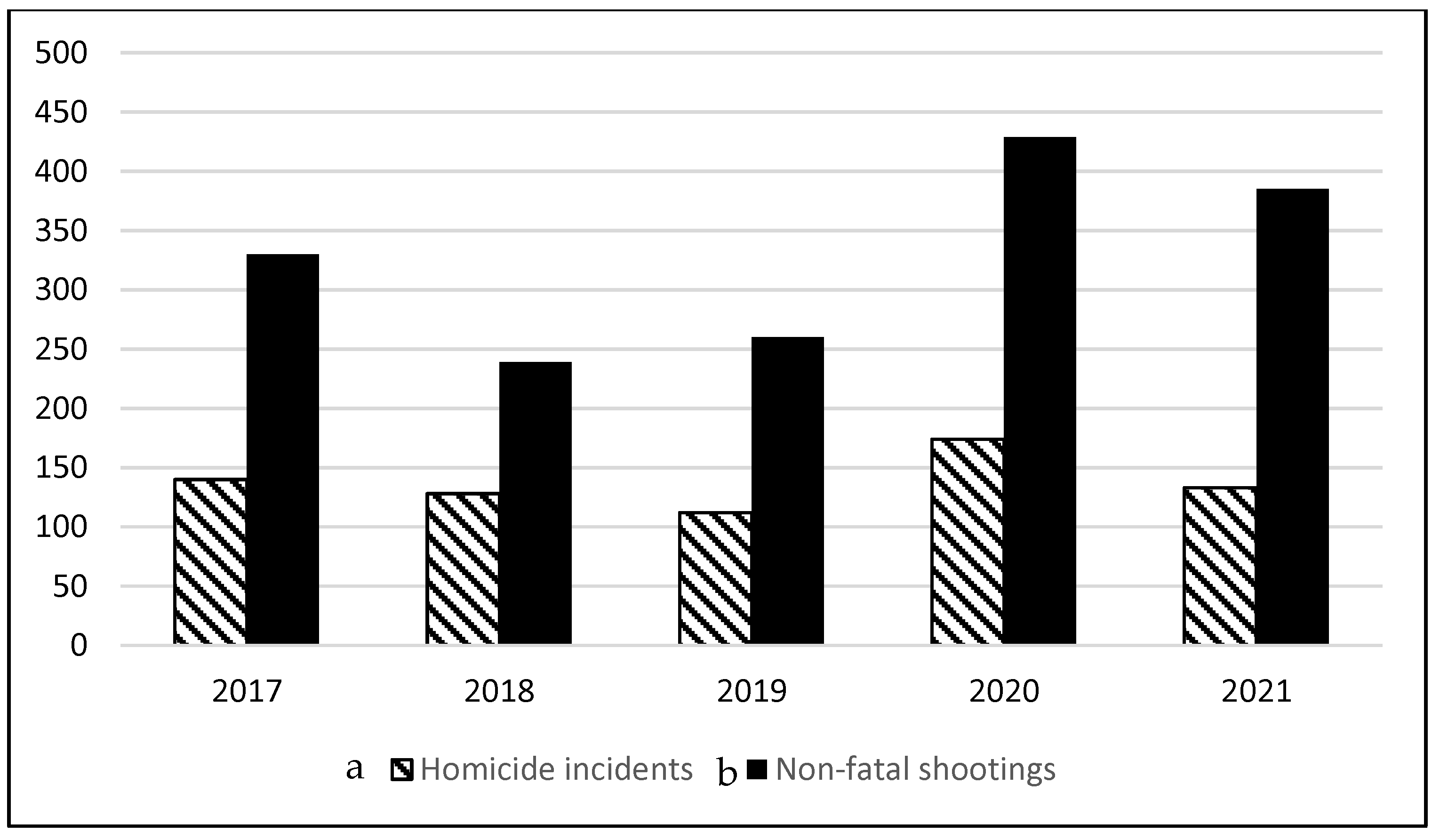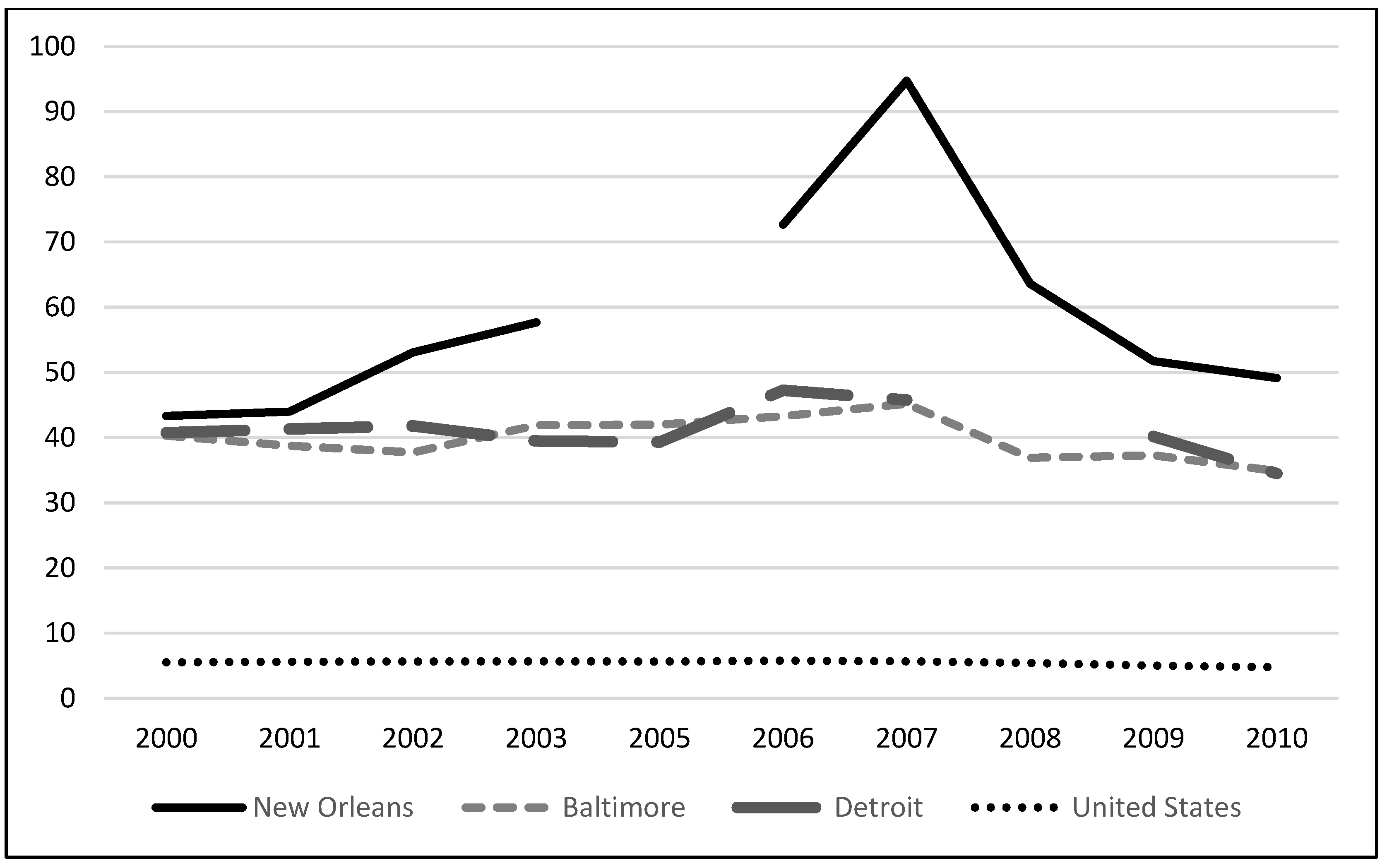Structural Barriers Associated with the Intersection of Traumatic Stress and Gun Violence: A Case Example of New Orleans
Abstract
1. Structural Barriers Associated with the Intersection of Traumatic Stress and Gun Violence: A Case Example of New Orleans
1.1. Social Determinants of Health
1.2. Psychological Stress and Trauma: Hurricane Katrina and COVID Pandemic
1.3. Addressing Structural Inequalities: Gun Violence as a Public Health Issue
1.4. Presence of Guns
1.5. Gun Violence as a Public Health Issue
1.6. Structural Barriers to Research
1.7. Barriers to Accessing Care
1.8. Need for Community-Level Interventions
2. Conclusions
Author Contributions
Funding
Institutional Review Board Statement
Informed Consent Statement
Data Availability Statement
Conflicts of Interest
References
- Louisiana Department of Health COVID-19 Information. Available online: https://ldh.la.gov/Coronavirus/ (accessed on 24 August 2021).
- Office of Criminal Justice Coordination. Calls for Service. New Orleans. Available online: https://nola.gov/office-of-criminal-justice-coordination/data/ (accessed on 14 October 2021).
- Gun Violence Archive. Available online: https://www.gunviolencearchive.org/ (accessed on 17 August 2021).
- Braveman, P.; Gruskin, S. Defining Equity in Health. J. Epidemiol. Community Health 2003, 57, 254–258. [Google Scholar] [CrossRef] [PubMed]
- Centers for Disease Control and Prevention. National Diabetes Statistics Report, 2020; Centers for Disease Control and Prevention, US Department of Health and Human Services: Atlanta, GA, USA, 2020; pp. 12–15.
- Blomme, C.; Roubal, A.; Givens, M.; Johnson, S.; Brown, L. University of Wisconsin Population Health Institute: County Health Rankings State Report 2020. Available online: https://www.countyhealthrankings.org/reports/state-reports/2020-louisiana-report (accessed on 19 October 2021).
- New Orleans Health Department. 2013 New Orleans Community Health Improvement Report: Community Health Profile & Community Health Improvement Plan. Available online: www.naccho.org (accessed on 19 October 2021).
- New Orleans Health Department. 2013 Health Disparities in New Orleans. Available online: https://www.nola.gov/health-department/ (accessed on 19 October 2021).
- Cabrera, J.F.; Kwon, R. Income Inequality, Household Income, and Mass Shooting in the United States. Front. Public Health 2018, 6, 294. [Google Scholar] [CrossRef] [PubMed]
- Robert, T.E.; Kelly, V.A. Disaster Mental Health. In Critical Incidents in Integrating Spirituality into Counseling; American Counseling Association: Alexandria, VA, USA, 2015; pp. 117–126. [Google Scholar]
- The Data Center Total Population New Orleans. Available online: https://www.datacenterresearch.org/data-resources/population-by-parish/ (accessed on 26 August 2021).
- Deitz, S.L.; Barber, K.M. Geographies of Inequality: Urban Renewal and the Race, Gender, and Class of Post-Katrina New Orleans. Race Gend. Cl. 2015, 134–159. [Google Scholar]
- Hamel, L.; Firth, J.; Brodie, M.; Jankiewicz, A.; Rousseau, D. Public Opinion of the ACA at the End of the First Open Enrollment Period. JAMA 2014, 311, 1957. [Google Scholar] [CrossRef][Green Version]
- USA Department of Justice Federal Bureau of Investigation. Crime in the United States. (2000–2010). Available online: https://www.fbi.gov/services/cjis/ucr/publications (accessed on 11 October 2021).
- Yancy, C.W. COVID-19 and African Americans. JAMA 2020, 323, 1891–1892. [Google Scholar] [CrossRef]
- Himle, J.A.; Baser, R.E.; Taylor, R.J.; Campbell, R.D.; Jackson, J.S. Anxiety Disorders among African Americans, Blacks of Caribbean Descent, and Non-Hispanic Whites in the United States. J. Anxiety Disord. 2009, 23, 578–590. [Google Scholar] [CrossRef] [PubMed]
- Rabelo, I.; Lee, V.; Fallah, M.P.; Massaquoi, M.; Evlampidou, I.; Crestani, R.; Decroo, T.; Van den Bergh, R.; Severy, N. Psychological Distress among Ebola Survivors Discharged from an Ebola Treatment Unit in Monrovia, Liberia—A Qualitative Study. Front. Public Health 2016, 4, 142. [Google Scholar] [CrossRef]
- Kessler, R.C.; Galea, S.; Gruber, M.J.; Sampson, N.A.; Ursano, R.J.; Wessely, S. Trends in Mental Illness and Suicidality after Hurricane Katrina. Mol. Psychiatry 2008, 13, 374–384. [Google Scholar] [CrossRef]
- Purtle, J. Racial and Ethnic Disparities in Post-Disaster Mental Health: Examining the Evidence through a Lens of Social Justice. Wash. Lee J. Civ. Rts. Soc. Just. 2012, 19, 31. [Google Scholar]
- Substance Abuse and Mental Health Services Administration. 2012 National Survey on Drug Use and Health: New Orleans-Metairie-Kenner, LA. Available online: https://www.samhsa.gov/data/report/new-orleans-metairie-kenner-la (accessed on 19 October 2021).
- Wadsworth, M.E.; Santiago, C.D.; Einhorn, L. Coping with Displacement from Hurricane Katrina: Predictors of One-Year Post-Traumatic Stress and Depression Symptom Trajectories. Anxiety Stress Coping 2009, 22, 413–432. [Google Scholar] [CrossRef]
- Ali, J.S.; Farrell, A.S.; Alexander, A.C.; Forde, D.R.; Stockton, M.; Ward, K.D. Race Differences in Depression Vulnerability Following Hurricane Katrina. Psychol. Trauma: Theory Res. Pract. Policy 2017, 9, 317. [Google Scholar] [CrossRef]
- Czeisler, M.É.; Lane, R.I.; Petrosky, E.; Wiley, J.F.; Christensen, A.; Njai, R.; Weaver, M.D.; Robbins, R.; Facer-Childs, E.R.; Barger, L.K. Mental Health, Substance Use, and Suicidal Ideation during the COVID-19 Pandemic—United States, 24–30 June 2020. Morb. Mortal. Wkly. Rep. 2020, 69, 1049. [Google Scholar] [CrossRef]
- Holingue, C.; Badillo-Goicoechea, E.; Riehm, K.E.; Veldhuis, C.B.; Thrul, J.; Johnson, R.M.; Fallin, M.D.; Kreuter, F.; Stuart, E.A.; Kalb, L.G. Mental Distress during the COVID-19 Pandemic among US Adults without a Pre-Existing Mental Health Condition: Findings from American Trend Panel Survey. Prev. Med. 2020, 139, 106231. [Google Scholar] [CrossRef]
- McKnight-Eily, L.R.; Okoro, C.A.; Strine, T.W.; Verlenden, J.; Hollis, N.D.; Njai, R.; Mitchell, E.W.; Board, A.; Puddy, R.; Thomas, C. Racial and Ethnic Disparities in the Prevalence of Stress and Worry, Mental Health Conditions, and Increased Substance Use among Adults during the COVID-19 Pandemic—United States, April and May 2020. Morb. Mortal. Wkly. Rep. 2021, 70, 162. [Google Scholar] [CrossRef]
- Franklin, J.C.; Ribeiro, J.D.; Fox, K.R.; Bentley, K.H.; Kleiman, E.M.; Huang, X.; Musacchio, K.M.; Jaroszewski, A.C.; Chang, B.P.; Nock, M.K. Risk Factors for Suicidal Thoughts and Behaviors: A Meta-Analysis of 50 Years of Research. Psychol. Bull. 2017, 143, 187. [Google Scholar] [CrossRef]
- Shearer, A.; Herres, J.; Kodish, T.; Squitieri, H.; James, K.; Russon, J.; Atte, T.; Diamond, G.S. Differences in Mental Health Symptoms across Lesbian, Gay, Bisexual, and Questioning Youth in Primary Care Settings. J. Adolesc. Health 2016, 59, 38–43. [Google Scholar] [CrossRef] [PubMed]
- Joe, S.; Baser, R.E.; Breeden, G.; Neighbors, H.W.; Jackson, J.S. Prevalence of and Risk Factors for Lifetime Suicide Attempts among Blacks in the United States. JAMA 2006, 296, 2112–2123. [Google Scholar] [CrossRef] [PubMed]
- Cheref, S.; Talavera, D.; Walker, R.L. Perceived Discrimination and Suicide Ideation: Moderating Roles of Anxiety Symptoms and Ethnic Identity among Asian American, African American, and Hispanic Emerging Adults. Suicide Life-Threat. Behav. 2019, 49, 665–677. [Google Scholar] [CrossRef] [PubMed]
- Curtin, S.C.; Hedegaard, H. Suicide Rates for Females and Males by Race and Ethnicity: United States, 1999 and 2017. NCHS Health E-Stat. 2019. Available online: https://www.cdc.gov/nchs/data/hestat/suicide/rates_1999_2017.htm (accessed on 27 November 2021).
- Anestis, M.D.; Bryan, C.J. Threat Perceptions and the Intention to Acquire Firearms. J. Psychiatr. Res. 2021, 133, 113–118. [Google Scholar] [CrossRef] [PubMed]
- National Shooting Sports Foundation. Available online: https://www.nssf.org/articles/nssf-survey-reveals-broad-demographic-appeal-for-firearm-purchases-during-sales-surge-of-2020/ (accessed on 26 August 2021).
- Bailey, R.K. At Gunpoint: Firearms Violence from a Psychiatrist’s Perspective; Outskirts Press: Denver, CO, USA, 2018. [Google Scholar]
- Rostron, A. The Dickey Amendment on Federal Funding for Research on Gun Violence: A Legal Dissection. Am. J. Public Health 2018, 108, 865–867. [Google Scholar] [CrossRef]
- Center for Behavioral Health Statistics and Quality. Racial/Ethnic Differences in Mental Health Service Use among Adults and Adolescents (2015–2019); Substance Abuse and Mental Health Services Administration: Rockville, MD, USA, 2021.
- Wyatt, G.E. Enhancing cultural and contextual intervention strategies to reduce HIV/AIDS among African Americans. Am. J. Public Health 2009, 99, 1941–1945. [Google Scholar] [CrossRef]
- Chang, C.; PW Bynum, J.; Lurie, J.D. Geographic Expansion of Federally Qualified Health Centers 2007–2014. J. Rural Health 2019, 35, 385–394. [Google Scholar] [CrossRef]
- Cuthbertson, C.A.; Newkirk, C.; Ilardo, J.; Loveridge, S.; Skidmore, M. Angry, Scared, and Unsure: Mental Health Consequences of Contaminated Water in Flint, Michigan. J. Urban Health 2016, 93, 899–908. [Google Scholar] [CrossRef]
- Kennedy, B.R.; Mathis, C.C.; Woods, A.K. African Americans and Their Distrust of the Health Care System: Healthcare for Diverse Populations. J. Cult. Divers. 2007, 14, 56–60. [Google Scholar]
- Hatzenbuehler, M.L.; McLaughlin, K.A.; Keyes, K.M.; Hasin, D.S. The Impact of Institutional Discrimination on Psychiatric Disorders in Lesbian, Gay, and Bisexual Populations: A Prospective Study. Am. J. Public Health 2010, 100, 452–459. [Google Scholar] [CrossRef] [PubMed]
- Lewis, T.T.; Cogburn, C.D.; Williams, D.R. Self-Reported Experiences of Discrimination and Health: Scientific Advances, Ongoing Controversies, and Emerging Issues. Annu. Rev. Clin. Psychol. 2015, 11, 407–440. [Google Scholar] [CrossRef]
- Rubix Life Sciences COVID-19 and Minority Health Access. Available online: https://rubixls.com/wp-content/uploads/2020/04/COVID-19-Minority-Health-Access-7-1.pdf (accessed on 12 August 2021).
- Benson, N.M.; Myong, C.; Newhouse, J.P.; Fung, V.; Hsu, J. Psychiatrist Participation in Private Health Insurance Markets: Paucity in the Land of Plenty. Psychiatr. Serv. 2020, 71, 1232–1238. [Google Scholar] [CrossRef] [PubMed]
- Mark, T.L.; Parish, W.; Zarkin, G.A.; Weber, E. Comparison of Medicaid reimbursements for psychiatrists and primary care physicians. Psychiatr. Serv. 2020, 71, 947–950. [Google Scholar] [CrossRef] [PubMed]
- Ross, K.M.; Gilchrist, E.C.; Melek, S.P.; Gordon, P.D.; Ruland, S.L.; Miller, B.F. Cost Savings Associated with an Alternative Payment Model for Integrating Behavioral Health in Primary Care. Transl. Behav. Med. 2019, 9, 274–281. [Google Scholar] [CrossRef] [PubMed]
- Lee, E.-K.O.; Shen, C.; Tran, T.V. Coping with Hurricane Katrina: Psychological Distress and Resilience among African American Evacuees. J. Black Psychol. 2009, 35, 5–23. [Google Scholar] [CrossRef]
- Palmer, K.N.; Rivers, P.S.; Melton, F.L.; McClelland, D.J.; Hatcher, J.; Marrero, D.G.; Thomson, C.A.; Garcia, D.O. Health Promotion Interventions for African Americans Delivered in US Barbershops and Hair Salons-a Systematic Review. BMC Public Health 2021, 21, 1–21. [Google Scholar] [CrossRef] [PubMed]



Publisher’s Note: MDPI stays neutral with regard to jurisdictional claims in published maps and institutional affiliations. |
© 2021 by the authors. Licensee MDPI, Basel, Switzerland. This article is an open access article distributed under the terms and conditions of the Creative Commons Attribution (CC BY) license (https://creativecommons.org/licenses/by/4.0/).
Share and Cite
Bailey, R.K.; Barker, C.H.; Grover, A. Structural Barriers Associated with the Intersection of Traumatic Stress and Gun Violence: A Case Example of New Orleans. Healthcare 2021, 9, 1645. https://doi.org/10.3390/healthcare9121645
Bailey RK, Barker CH, Grover A. Structural Barriers Associated with the Intersection of Traumatic Stress and Gun Violence: A Case Example of New Orleans. Healthcare. 2021; 9(12):1645. https://doi.org/10.3390/healthcare9121645
Chicago/Turabian StyleBailey, Rahn Kennedy, Chikira H. Barker, and Amit Grover. 2021. "Structural Barriers Associated with the Intersection of Traumatic Stress and Gun Violence: A Case Example of New Orleans" Healthcare 9, no. 12: 1645. https://doi.org/10.3390/healthcare9121645
APA StyleBailey, R. K., Barker, C. H., & Grover, A. (2021). Structural Barriers Associated with the Intersection of Traumatic Stress and Gun Violence: A Case Example of New Orleans. Healthcare, 9(12), 1645. https://doi.org/10.3390/healthcare9121645




